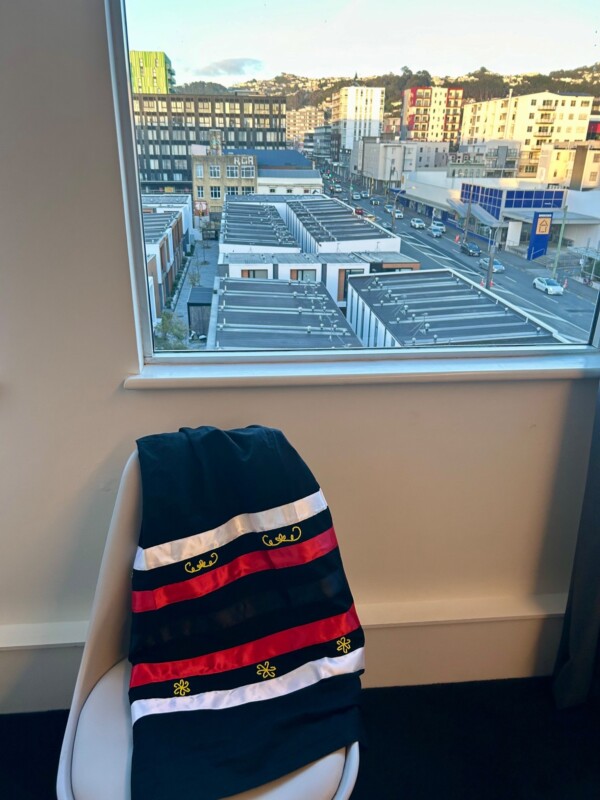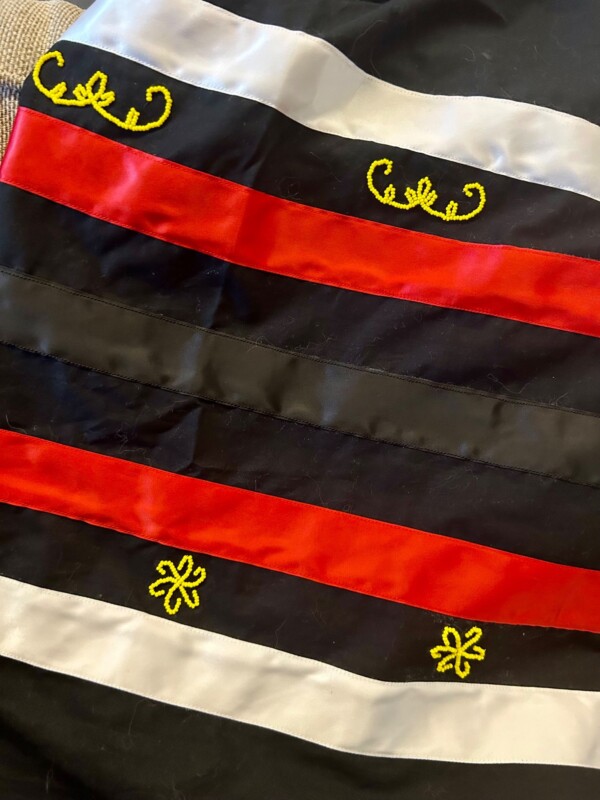From Mi’kma’ki to Aotearoa: Weaving a Journey of Rediscovery Through Ribbon Skirts
 Earlier this year, Kelly Paul, a Mi’kmaw woman from Membertou and recent graduate of Cape Breton University’s Bachelor of Hospitality and Tourism Management program, embarked on a transformational journey to Aotearoa—New Zealand—as part of the CBU Study Abroad program. Immersed in the vibrant Māori culture and traditions, Kelly found a powerful connection that resonated with both her Mi’kmaw heritage and her studies in tourism, where understanding cultural landscapes and fostering meaningful connections are essential.
Earlier this year, Kelly Paul, a Mi’kmaw woman from Membertou and recent graduate of Cape Breton University’s Bachelor of Hospitality and Tourism Management program, embarked on a transformational journey to Aotearoa—New Zealand—as part of the CBU Study Abroad program. Immersed in the vibrant Māori culture and traditions, Kelly found a powerful connection that resonated with both her Mi’kmaw heritage and her studies in tourism, where understanding cultural landscapes and fostering meaningful connections are essential.
This trip, which brought Kelly across the planet alongside five other students and two CBU faculty members,proved transformative. For Kelly, the experience inspired her to create a ribbon skirt symbolizing the cultural connections and the resilience shared between the Mi’kmaq and Māori. Through this project, Kelly has woven together her passion for cultural preservation, her Indigenous identity and the profound insights she brought back from her travels with CBU. “Creating a ribbon skirt is a deeply personal and meaningful experience for me. It represents a connection to my culture and the traditions of my ancestors,” says Kelly. “This skirt represents not only my culture but an effort to connect with the Māori people and their rich traditions.”
Discovering Cultural Parallels in Aotearoa
Kelly’s journey to Aotearoa (the Māori name for New Zealand) opened her eyes to the cultural pride and resilience of the Māori, which struck a familiar chord within her. “The similarities between the Mi’kmaq and Māori were mind-blowing,” she says. “They have so much respect for their language and culture, and it’s everywhere—on street signs, in their everyday lives. It inspired me to think about what’s possible for us.”
This sense of cultural revitalization, seen easily in the widespread public visibility of Māori language and symbolism, inspired Kelly to reflect on the importance of strengthening her own cultural ties and heritage. For Kelly, the trip became a moment of empowerment and pride, expressing a newfound commitment to storytelling and cultural preservation.
Witnessing how the Māori seamlessly integrate their traditions into modern life gave her a vision of what is achievable for Indigenous communities back home in Mi’kma’ki. “This whole process has empowered me,” she says “It’s made me proud to tell the story, share it with others and recognize that here too, we have a rich culture that we are working hard to reclaim.”
Crafting the Ribbon Skirt: A Cultural and Personal Statement
The idea of crafting a ribbon skirt was an extension of Kelly’s inspiration gained in her travels and, at the same time, a tribute to her Mi’kmaw heritage. Kelly says ribbon skirts, long embraced in Indigenous communities across Turtle Island (North America), symbolize identity, resilience and more.
“To me, a ribbon skirt symbolizes empowerment, cultural pride and femininity,” Kelly notes. “The resurgence of ribbon skirts among Indigenous girls, women and Two-Spirit individuals reflects a reclaiming of identity and a celebration of our unique stories and experiences. This mirrors the cultural revitalization efforts seen in both the Mi’kmaw and Māori communities, where reclaiming traditions and sharing cultural narratives are vital for connecting with our roots.”
As Kelly worked on the ribbon skirt, the process of designing it was both deeply emotional and hopeful, as she thought of the generations of women who came before her and will come after. She says she thought of her niece Solana and potential future children of her own.
“As I created this ribbon skirt, I found myself reflecting deeply on reclaiming my culture. The thought of my niece, Solana, deeply affected me, as I envisioned the legacy I want to pass down to her,” says Kelly. “I hope that by sharing these traditions and skills with Solana and hopefully, my future children, I can help her connect to her heritage and understand the strength that comes from our shared history.”
Kelly also explains that cultural reclamation is personal for her and that Mi’kmaw people have only just begun reclaiming the culture taken from them by force. She says the ribbon skirt is partly dedicated to her grandmother, who died before Kelly was born, and all the women who came before.”Creating the ribbon skirt connects me to my ancestors because I feel like my grandmother was super creative, and a lot of that was taken away from her. It feels like I’m reclaiming something that was lost for my family,” Kelly says. “Creating this skirt became a way for me to honour my grandmother and the generations of women who came before me.”
Symbolism in the Skirt’s Design
Each element of Kelly’s ribbon skirt was carefully chosen, symbolizing both her personal story and the broader Mi’kmaw and Māori traditions. In designing the skirt, Kelly explains she chose colours that represent the four directions of the medicine wheel—black, red, white and yellow. “This wheel symbolizes balance, harmony and the circle of life, resonating with both Mi’kmaw and Māori worldviews,” she says.
 Adding to the skirt’s cross-cultural elements, Kelly included representations of the yellow frangipani, a flower significant in Māori tattoo practices, to honour the traditions she encountered in New Zealand. The final design of the skirt became a tapestry of both cultures, rich in personal meaning and universal symbolism.
Adding to the skirt’s cross-cultural elements, Kelly included representations of the yellow frangipani, a flower significant in Māori tattoo practices, to honour the traditions she encountered in New Zealand. The final design of the skirt became a tapestry of both cultures, rich in personal meaning and universal symbolism.
Kelly also integrated beaded double curve motifs, traditional Mi’kmaw symbols of unity and interconnectedness. “The motif reflects the bond between our cultures and the importance of collaboration and understanding as we learn from one another,” she explains.
Emotional Reflections and the Cultural Journey
The emotional journey of creating the skirt allowed Kelly to reflect on her experience in New Zealand and her connection to her heritage. These reflections influenced the ribbon skirt’s design and connected Kelly’s experience in Aotearoa with her own path in reclaiming and preserving her Mi’kmaw heritage. “The emotional process of making the skirt really hit me during the talking circles in the course,” says Kelly. “Seeing how much knowledge is passed down in Māori culture made me reflect on my own experience and how I wasn’t brought up as closely with those traditions.”
Through her interactions with Māori people, Kelly recognized the universal threads connecting Indigenous communities across the world—family ties, storytelling and a shared commitment to cultural preservation. “I noticed right away,” she says. “Even before going, I had met a few people from New Zealand, and I saw the similarities in family ties and storytelling.”
A Responsibility to Future Generations
Kelly’s journey doesn’t end with her own connection to her heritage; she views spreading what she learned as part of her responsibility to future generations. The ribbon skirt is just a tangible expression of this commitment, one step in a long journey, a piece of her legacy for future generations. “It’s so important to revive these traditions and keep them fresh in people’s minds,” she says. “I want to teach these skills to others, including my niece, so that they can pass them down. It’s about preserving these life skills and recognizing their importance.”
Reflecting on her journey, Kelly expressed her desire to return to New Zealand someday, saying there is much more she has to learn, and even more she’d like to share.The experience, she says, has given her pride not only in her identity as a Mi’kmaw woman but also in the opportunity to celebrate her people’s stories, resilience and traditions on an international stage.
A Journey Woven in Threads of Tradition
Kelly’s journey from Mi’kma’ki to Aotearoa has come full circle, from a life-changing trip full of cultural enrichment to a personal project that celebrates the common ties between Indigenous peoples several thousand miles away, as well as her own experience, ancestors and legacy as a Mi’kmaw woman. The skirt she created is not just a garment but a symbol. For Kelly, the ribbon skirt is both a nod to the past and a gift to the future, bridging Mi’kmaw and Māori cultures in a symbol of Indigenous resilience, cross-cultural solidarity and her people’s ongoing journey of cultural reclamation.